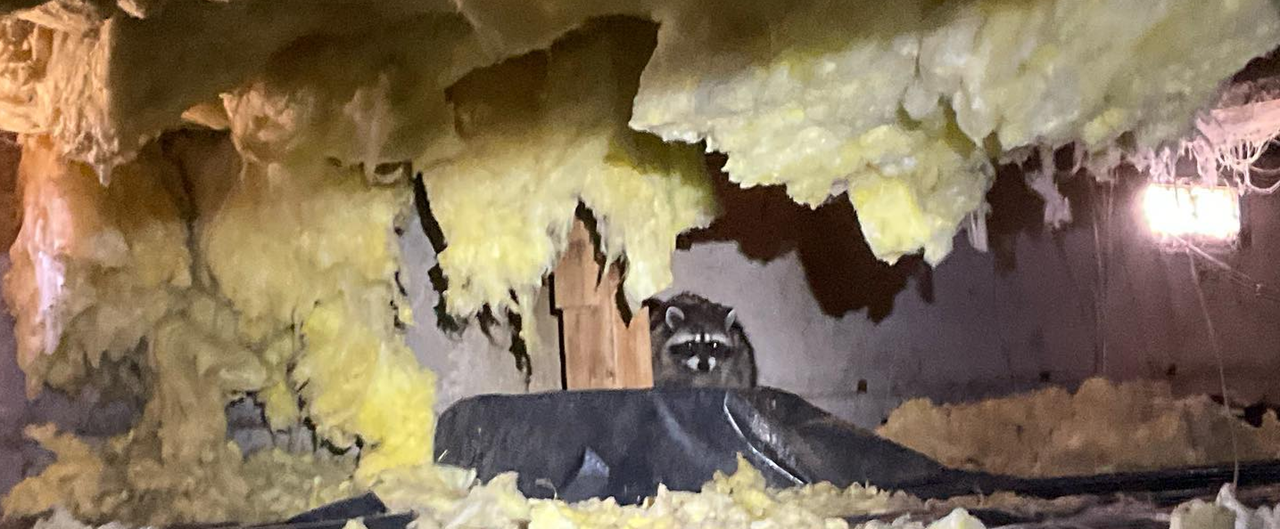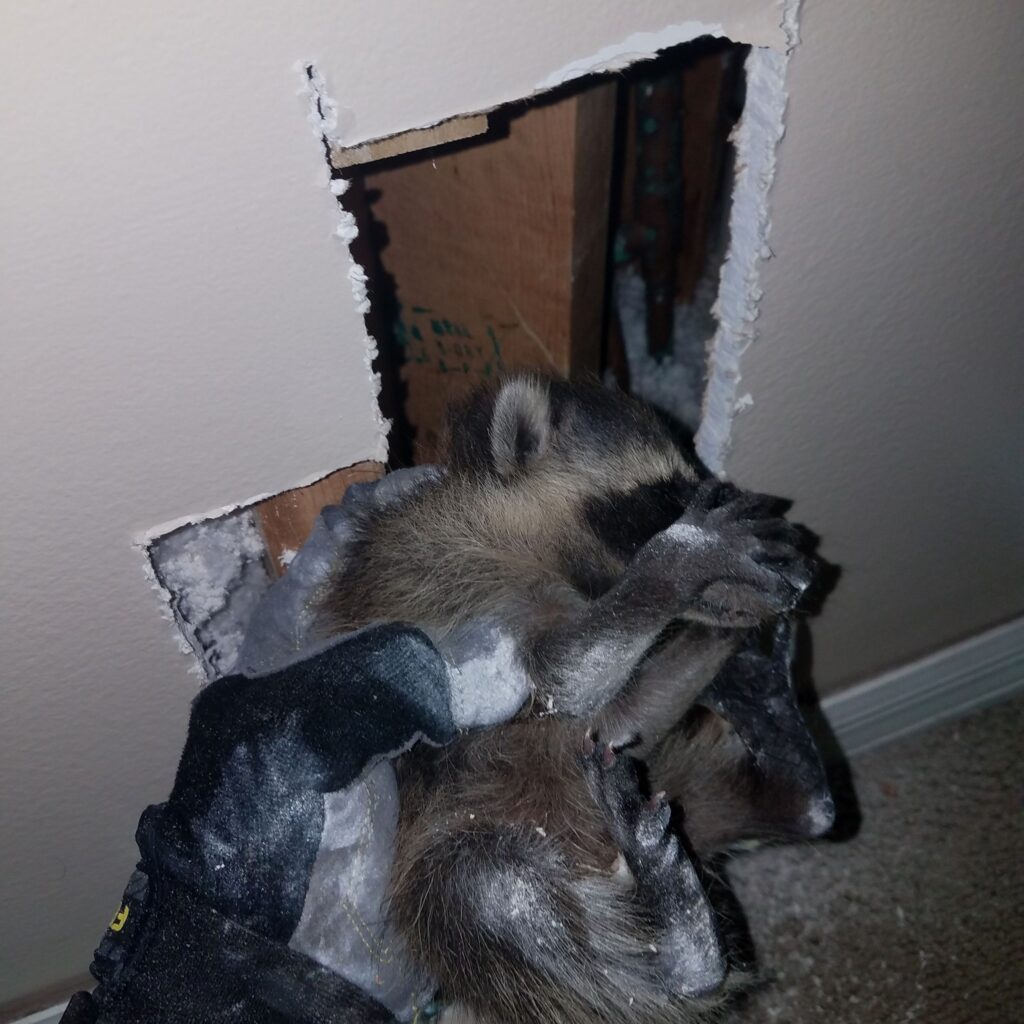
Table of Contents
- Raccoons in the House
- Raccoons in Attics
- Raccoons in the Chimneys
- Raccoons in Walls
- Raccoons in Basements
- Raccoons in Crawl Spaces
- Raccoons in Trash
- Raccoons on Roof
How to Get Rid of Raccoons in Walls
Raccoons are skilled in finding access points to homes, including cracks, crevices, and holes in building exteriors, screens, roofs, and siding. Once they gain entry to the building, they often establish dens in secluded areas like wall voids.
Signs of Raccoons in the Walls
Raccoons are skilled in finding access points to homes, including cracks, crevices, and holes in building exteriors, screens, roofs, and siding. Once they gain entry to the building, they often establish dens in secluded areas like wall voids.
- Noises from inside the wall
- Scratching, scurrying, or rustling sounds, especially at night
- High-pitched chattering or growling
- Visible damage
- Holes or entry points chewed through siding, screens, or roof vents
- Insulation or drywall that appears disturbed or damaged
- Droppings and waste
- Raccoon feces left around potential entry points or access areas
- Strong, musky odors from raccoon urine
- Paw prints
- Distinctive five-toed prints left on the exterior of the home
- Muddy or dusty paw prints around potential entry points
- Nesting materials
- Shredded insulation, leaves, paper, or other debris used to build a den
- Visible piles of these materials around the home’s exterior or attic
- Sightings
- Glimpses of the raccoon itself entering or exiting the home
- Raccoons spotted moving around the home at night
If homeowners notice any combination of these signs, it’s a strong indicator that a raccoon has made its way into the walls or other secluded areas of the home. Prompt action is advised to safely remove the animal and prevent further damage or health risks.
Dangers of Raccoons in Walls
Raccoon infestations can cause costly damage to property. This is especially true when they’ve established their presence in walls, where essential electrical wiring is located. Raccoons in walls significantly elevate the risk of electrical fire due to the creature’s curious nature. Perhaps more importantly, raccoon infestations are hazardous to your health. Raccoons can expose residents to rabies and other diseases, including raccoon roundworm.
How to Get a Raccoon Out of the Wall
Getting a raccoon out of the wall is one of the more difficult wildlife removal tasks. Raccoons are inside your wall either to build a den or by accident. In either situation, raccoon removal usually requires cutting a hole in the wall. If raccoon babies are present, we gently hand remove them from the wall. It gets trickier if it is an adult raccoon stuck in the wall. That requires securing the room, using a catch pole and a cage.
Due to these dangers, it’s imperative that property owners avoid contact with the animals. If you’ve identified a raccoon infestation, we highly recommend contacting the trained professionals at Critter Control. Our technicians are equipped with the tools and experience to safely and humanely remove raccoons from walls and any other problem areas on your property. Find the Critter Control office near you to discuss how we can help today

Raccoon in wall removal care of Critter Control in Dallas
Get them out.
Keep them out.®
Experiencing a wildlife or pest issue? We can help! Complete this form and your local Critter Control® office will contact you to assist.
- Noises from inside the wall
- Scratching, scurrying, or rustling sounds, especially at night
- High-pitched chattering or growling
- Visible damage
- Holes or entry points chewed through siding, screens, or roof vents
- Insulation or drywall that appears disturbed or damaged
- Droppings and waste
- Raccoon feces left around potential entry points or access areas
- Strong, musky odors from raccoon urine
- Paw prints
- Distinctive five-toed prints left on the exterior of the home
- Muddy or dusty paw prints around potential entry points
- Nesting materials
- Shredded insulation, leaves, paper, or other debris used to build a den
- Visible piles of these materials around the home’s exterior or attic
- Sightings
- Glimpses of the raccoon itself entering or exiting the home
- Raccoons spotted moving around the home at night
If homeowners notice any combination of these signs, it’s a strong indicator that a raccoon has made its way into the walls or other secluded areas of the home. Prompt action is advised to safely remove the animal and prevent further damage or health risks.
- How to Get Rid of Raccoons
- Are Raccoons Dangerous?
- Raccoon Trapping Service
- Raccoon Control
- Baby Raccoons
- Dead Raccoon Removal
- Raccoon Diseases
- Do Raccoons Hibernate in Winter?
- Raccoon Damage
- Raccoon Diet
- Raccoon Poop
- Raccoons In Yards
- Raccoons in Basements
- Raccoons in Chimneys
- Raccoons in Crawl Spaces
- Raccoons in Houses
- Raccoons in Trash
- Raccoons in Trees
- Raccoons on Roofs & in Soffits
- Raccoon Sounds
- Raccoon Tracks
- Raccoons in Attics & Ceilings
- What Does a Raccoon Look Like?